tel.: +7 (383) 316-51-37
fax: +7 (383) 330-84-80
Keynote Speakers
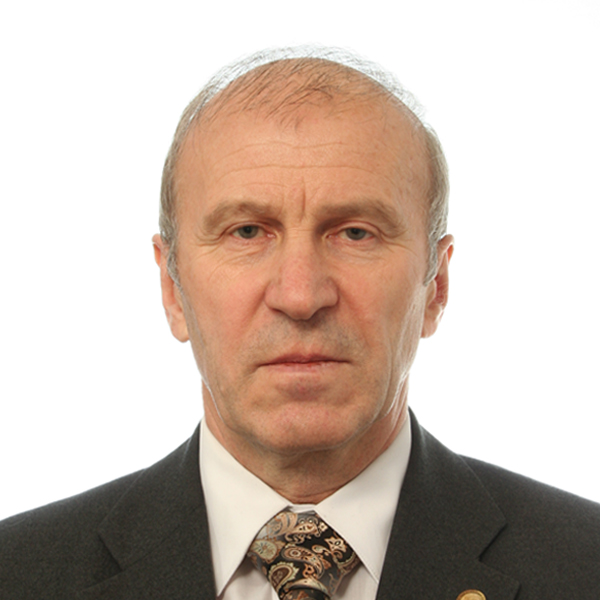
3D instability of liquid films and rivulets
Sergey V. Alekseenko
Prof. Sergey V. Alekseenko
Corresponding member of Russian Academy of Sciences
Director of the Kutateladze Institute of Thermophysics
Lavrentyev Ave., 1, 630090, Novosibirsk, Russia
aleks@itp.nsc.ru
Sergey Alekseenko is a Director of the Kutateladze Institute of Thermophysics. He is a Professor and Head of Chair of Physics of Nonequilibrium Processes, Novosibirsk State University. He is a Corresponding member of Russian Academy of Sciences, member of American Physical Society, Society of Chemical Industry and EUROMECH. He is a member of Assembly of World Conferences on Experimental Heat Transfer, Fluid Mechanics and Thermodynamics, member of ISMF Governing Board, and member of European Fluid Mech. Conf. Committee. His areas of expertise are the transport phenomena in two-phase flow, hydrodynamics of film flow, wave phenomena, vortex flows and turbulent jets, experimental methods for two-phase flows, power engineering and energy saving. He has 115 published papers in refereed journals, 25 patents, four monographs including Wave Flow of Liquid Films (Begell House 1994) and Theory of Concentrated Vortices (Springer 2007).
Abstract
The extended abstract is available here.

Effect of Tube Diameter on Void Fraction Characteristics of One-Component Vertically Upward Two-Phase Flows
Hitoshi Asano
Prof. Hitoshi Asano
Kobe University, Graduate School of Engineering
Department of Mechanical Engineering
1-1 Rokkodai, Nada, Kobe 657-8501, Japan
asano@mech.kobe-u.ac.jp
Hitoshi Asano is an associate professor of Dept. Mechanical Engineering in Kobe University, Japan. He graduated from Kobe University in 1990. He started research on two-phase flow dynamics as a research associate of Kobe University after 3.5 years working in Daikin Industries, Ltd. He obtained degree of Dr. Eng. from Kobe University in 2000, and was promoted to associate professor in 2001. From 2001 to 2002 he visited the laboratory of Prof. Mueller-Steinhagen in Stuttgart University as a research fellow of the Alexander von Humboldt foundation, and started the investigation on boiling heat transfer enhancement by thermal spraying. Recently, he studies on the effect of surface structures on boiling heat transfer including ONB, DNB, and dryout. His interests is also focused on thermo-fluid dynamics in compact heat exchangers for HVAC systems, gas-liquid two-phase flows in power systems, especially the effect of surface tension and gravity on gas-liquid two-phase flows in small diameter tubes.
Abstract
The purpose of this study is to clarify the transition boundaries in the dominant force map, especially to clarify the condition in which the effect of gravity becomes little in comparison with the effect of surface tension. Void fraction characteristics of vertically upward flows in small circular tubes were measured by a capacitance sensor. FC-72 as the working fluid. The effect of the tube diameter was examined for moderately-small diameter tubes with the diameter of 4.0, 2.0, 1.1 and 0.5 mm. Flow patterns, void fraction fluctuations, average void fractions for varied mass flux and vapor quality will be presented.
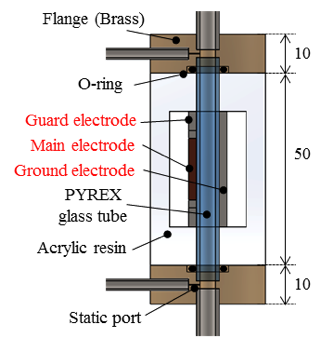 Detail of capacitance probe.
Detail of capacitance probe.
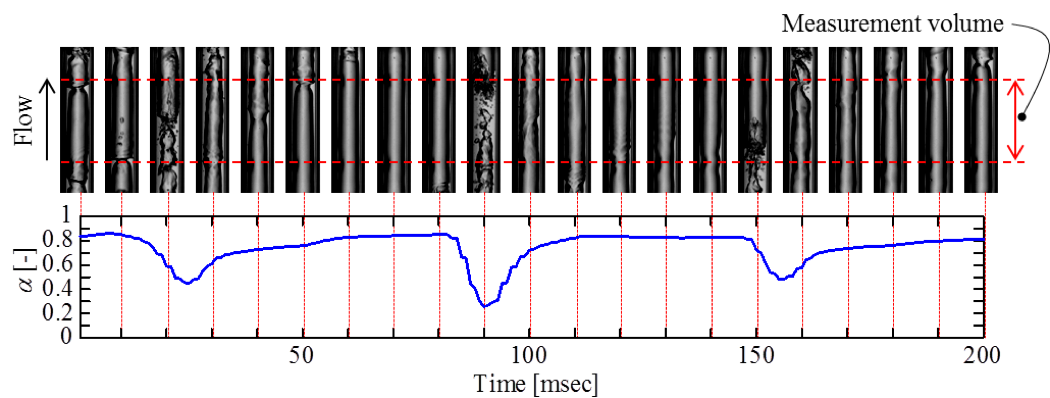 Measured example of void fraction fluctuation
Measured example of void fraction fluctuation
(Din=2.0 mm, G=150 kg/(m2s), x=0.15, aave=0.75, Semi-annular flow).

Thermofluid Characteristics of High Quality Microgap Flow
Avram Bar-Cohen
Prof. Avram Bar-Cohen
Distinguished University Professor
University of Maryland - College Park
Department of Mechanical Engineering
TherPES Laboratory
2106B Glenn Martin Hall, Maryland, 20742,USA
abc@umd.edu
Dr. Avram Bar-Cohen is an internationally recognized leader in thermal science and technology, an Honorary member of ASME, and Life Fellow of IEEE, as well as Distinguished University Professor in the Department of Mechanical Engineering at the University of Maryland. His publications, lectures, short courses, and research, as well as his US government and professional service in ASME and IEEE, have helped to create the scientific foundation for the thermal management of electronic components and systems. His current research focuses on embedded cooling, including on-chip thermoelectric and two-phase microchannel coolers for high heat flux electronic components, thermal control of photonic and solid-state lasers, and polymer-fiber composite heat exchangers for seawater applications.
In 2014 Bar-Cohen was honored by the IEEE with the prestigious CPMT Field Award and had earlier been recognized with the Luikov Medal from the International Center for Heat and Mass Transfer in Turkey (2008) and ASME's Heat Transfer Memorial Award (1999), among other awards. Bar-Cohen serves as the Editor-in-Chief of WSPC's Encyclopedia of Thermal Packaging and is the co-editor of the Advanced Integration and Packaging book series. Bar-Cohen has co-authored 3 books, edited/co-edited 24 books and has authored/co-authored nearly 400 journal papers, refereed proceedings papers, and chapters in books. He has advised to completion 70 master's and PhD students at the University of Maryland, the University of Minnesota and the Ben Gurion University (Beer Sheva, Israel), where he began his academic career in 1972.
Abstract
The ongoing demand for greater compactness, higher functionality, and higher feature count in electronic components, as well as the emergence of the three-dimensional packaging paradigm, continue to drive chip power dissipation, heat flux, and heat density to higher values. High-quality, microfluidic evaporative cooling, with dielectric liquids flowing in a microgap adjacent to a single active chip or in the microgaps between chips in a chips stack, offers highly potent thermal management capability and is the foundation for the emerging "embedded cooling" paradigm of electronic cooling. While the thermofluid characteristics of such flows are intimately tied to distinct forms of vapor-liquid aggregation, insufficient attention has been paid to characterizing the regimes, sub-regimes, and interfacial wave patterns in high-quality microgap channel flow.
This Keynote presentation will open with a review of the thermophysical phenomena underpinning two-phase microgap flow and heat transfer, followed by a brief survey of microgap studies underway around the world. Attention will then be focused on 3 recent studies in the TherPES Laboratory at UMD: a fundamental study of flow patterns and thin film behavior in a "long" microgap channel, a fundamental visualization study of a "chip-scale" microgap channel using visible and IR wavelengths, and an applied study of microgap thermal management, using a thermally-simulated microprocesor chip.

Mechanical Properties of Complex Fluid Interfaces: Underlying Mechanisms at Molecular Scale and Effects on Drop Dynamics
BoFeng Bai
Prof. BoFeng Bai
State Key Laboratory of Multiphase Flow in Power Engineering
Xi’an Jiaotong University, Xi’an, 710049, China
bfbai@mail.xjtu.edu.cn
Dr. BoFeng Bai is a Professor in the State Key Laboratory of Multiphase Flow in Power Engineering at Xi'an Jiaotong University. He received B Sc and Ph.D at Xi'an Jiaotong University in 1993 and 1999, respectively. His current research interests are mainly engaged in fundamental studies of multiphase flow and heat mass transfer and related applications in thermal power engineering and petroleum engineering. In 2014, Dr. Bai received the Distinguished Young Scientists award from National Science Foundation China. He is also honored New Century Excellent Talents in Universities by the National Ministry of Education in 2004. As the second contributor, Dr. Bai won the second prize of the National Awards for Technological Inventions in 2009. In the recent 5 years, he published more than 50 peer-reviewed papers in international journals including J Fluid Mech, Phys Fluids, Chem Eng Sci, etc. Dr. Bai is an editorial board member for four international journals including Interfacial Phenomena and Heat Transfer. Currently, he is the council member of the Chinese Engineering Thermophysics Society.
Abstract
Studying interfacial phenomena in multiphase flow has been an important branch of the discipline of thermophysics. Complex fluid interfaces consisting of various types of molecules are extensively found in nature and engineering applications. For instance, surfactants/nanoparticles can appear on oil/water/gas interfaces in petroleum engineering; biological membranes consist of lipid bilayers with spectrin proteins. The presence of various molecules confers interfaces special mechanical properties, such as resistances to shear, area dilatation and bending. We performed a systematic study to reveal mechanisms of mechanical properties of complex fluid interfaces using molecular dynamics simulations and investigated deformation, dynamics and adhesion of droplets with complex interfaces basing on a front tracking-finite difference method. Our methods and results can be helpful for understanding interfacial phenomena in complex multiphase flows and for further developing related technologies such as surfactants/nanoparticles assisted enhanced oil recovery in petroleum engineering and capsule assisted substance delivery in chemical and biomedical engineering.

Two-Layer Fluid Flows With Evaporation: Analytical Methods and Comparison with Experiments
Victoria Bekezhanova
Victoria Bekezhanova
Institute of Computational Modelling SB RAS
Department of Differential Equations of Mechanics
Department of Differential Equations of Mechanics
50/44, Akademgorodok, Krasnoyarsk, Russia, 660036
vbek@icm.krasn.ru
Victoria Bekezhanova is currently a Senior Researcher of Department of Differential Equations of Mechanics at the Institute of computational Modeling SB RAS and Associate Professor of the Institute of Mathematics and Computer Science at the Siberian Federal University (Krasnoyarsk). In 2003 she received the PhD degree in the Institute of Hydrodynamics SB RAS (Novosibirsk) with analytical and numerical investigation on stability of exact solutions of microconvection equations. Her research interests include the analysis of exact solutions and their stability in non-classical convection models, multiphase flows. She is a member of the European Mechanics Society.
Abstract
An overview of the analytical methods is presented to study the problems on two-layer flows with evaporation and appearing difficulties. The methods include the construction of the physically meaningful and correct mathematical models, constructing, analysis and interpretation of the exact solutions and their generalization within the frame of the selected model, investigation of the stability of the exact solutions. The results of such analysis can lead to improvement of the mathematical model in order to describe the investigated flows more adequately. In the case of the multiparameter problem we can examine the degree of influence of the different physical factors on the characteristics of flows and criteria of their stability. Results of the analytical investigations of features and characteristics of the two-layer flows with evaporation in a channel on the basis of the exact solution (solution of special type) of the convection equations and comparison with experiments will be presented. Effects of the gas flow rates and thermal loads at the channel boundaries on topology of the fluid flows will be discussed.
The extended abstract is available here.

Thin liquid films flowing down heated walls: a review of recent results
Luis Antonio Dávalos O.
Prof. Luis Antonio Dávalos O.
Departamento de Polímeros, Instituto de Investigaciones en Materiales
Universidad Nacional Autónoma de México
Ciudad Universitaria, Circuito Exterior S/N
Delegación Coyoacán, 04510 México D. F.
ldavalos@unam.mx
Luis Dávalos received his B. Sc. degree in Physics from the Faculty of Science, Universidad Nacional Autónoma de México (UNAM) in 1977. He obtained his Master in Science and Doctor in Science degrees at the Faculty of Science of the University of Tokyo, Japan in 1981 and 1984, respectively. His major was in Theoretical Fluid Dynamics. He became Associate Professor in 1984 and Professor in 1992 at the Department of Polymers, Instituto de Investigaciones en Materiales, UNAM. He also has been a Visiting Scientist at the Hosei University, Tokyo, Japan in 1990, at the Northwestern University, Department of Engineering Science and Applied Mathematics, USA in 1992 - 1993, and twice at the Universität Bayreuth, Department of Theoretical Physics IV, Germany in 1999 and in 2000 - 2001. His research interests are focused on Theoretical Fluid Mechanics of Newtonian and non Newtonian Fluids and in particular on the Instability of Thin Films Flowing Down Walls, Instabilities in Stratified Fluids, Natural convection and Thermocapillary convection.
Abstract
Thin liquid films have been the subject of research since many years ago due to their important applications in industry. The difficulty of having a smooth surface after liquid film solidification has motivated a number of scientists to investigate the instability of those films in order to understand how to control its behavior. Other relevant subject of research is the cooling of surfaces and walls when there is heat generation and it is not possible to dissipate it in an easy way but with thin liquid films. In this lecture a review is presented of important results published in the open literature on thin liquid films flowing down walls. The goal is to discuss the current publications on the subject which appeared since the author’s review paper published in IPHT 1 / 2 (2013) 93 - 138.
The extended abstract is available here.

Moving contact lines
Stephen H. Davis
Prof. Stephen H. Davis
Department ESAM, Northwestern University
Evanston, IL 60208 USA
sdavis@northwestern.edu
Stephen H. Davis, McCormick School (Institute) Professor and Walter P. Murphy Professor of Applied Mathematics at Northwestern University, received all his degrees at Rensselaer Polytechnic Institute (Ph.D. in Mathematics 1964). He has been Research Mathematician at the RAND Corporation, Lecturer in Mathematics at Imperial College, London, and Assistant, Associate Professor and Full Professor of Mechanics at the Johns Hopkins University. He was Editor of the Journal of Fluid Mechanics and is the Editor of Annual Review of Fluid Mechanics. He has authored over two hundred refereed technical papers in the fields of Fluid Mechanics and Materials Science, and has written a book "Theory of Solidification". He has twice been Chairman of the Division of Fluid Dynamics of the American Physical Society, is a Fellow of the American Physical Society, member of the National Academy of Sciences, the National Academy of Engineering, and the American Academy of Arts and Sciences, is the 1994 recipient of the Fluid Dynamics Prize of the American Physical Society and the 2001 G. I. Taylor Medal of the Society of Engineering Science.
Abstract
Before 1970 no researchers understood that the mutual displacement of a liquid by another liquid or gas poses a severe modeling problem. it was not until Hu & Scriven (1971) and Dussan V & Davis (1974) that it became clear that such mutual displacement requires the loss of the no-slip boundary condition at the substrate. This evolution seemed complete in describing the macroscopic behavior of drops until the experiments of Saiz & Tomasia (2005) on liquid metallic drops at elevated temperatures spreading on Mb substrates which showed definitively that the data departed from theory and instead followed the molecular-kinetic theory (Blake 1969) in which fluid flow is absent and molecules of liquid hop from the drop onto the substrate ahead of the contact line effectively advancing it. This led to the further consideration of the later theory. Later Davis & Davis (200 ) examined both theories in conjunction with metallic macroscopic contact angle verses contact-line speed cross and argued that the spreading initially at high speed follows the hydrodynamic theory until the crossing point and then switches to the molecular theory, and one might expect this to be the case in every spreading experiment. Recently, Karim, Davis, and Kavehpour (2016) show that spreading drops follow the theories above but that forced contact lines diverge and follow the molecular-kinetic theory. Thus, the early "simplicity" has been replaced by a complex array of behaviors which must be understood in properly interpreting experimental observations.
References
- Blake, T.D. & Haynes, J.M. Kinetics of liquid/liquid displacement, J. Coll. Interf. Sci. 30, 421-423 (1969).
- Davis, S.H. Droplet spreading: Theory and experiment. Comte Renduz Phys. 14, 629-635 (2013).
- Dussan V, E.B. & Davis, S.H. The motion of a fluid-fluid interface along a solid surface. J.Fluid Mech. 65, 71-95 (1974).
- Huh,C. & Scriven, L.E .Hydrodynamic model of steady movement of drops and showedthat the curves of a solid/liquid/fluid contact line. J. Coll. Interf. Sci. 35, 85-101 (1971).
- Karim, A.M., Davis, S.H. & Kavehpour, H.P. Forced verses free spreading of liquids. (2016) unpublished.
- Saiz, E. & Tomasia, A.P. Kinetics of high temperature spreading. Curr. Opin. Solid State Mater. Sci. 9, 167-173 (2005).

Gas-liquid interface simulations in the light of the kinetic theory
Irina Graur Martin
Prof. Irina Graur
IUSTI Laboratory, 7343 UMR CNRS, Aix Marseille University
5 rue E.Fermi,13453 Marseille, France
irina.martin@univ-amu.fr
Prof. Irina Graur obtained M.Sc. in applied mathematics in 1984 from Moscow Lomonossov State University. She received a PhD also from Moscow State University in 1989 and the Habilitation from Provence University in France in 2008. Irina Graur was associate professor at Keldish Institute of Applied Mathematics between 1984 and 2000. She is currently professor at Aix Marseille University in France. She has made a number of contributions in the field of rarefied gases for the aerospace research. Her current research interests include the experimental and numerical characterization of the gas properties at micro and nano scales. She heads the research group "Non-equilibrium phenomena and microfluidic". She participated in the organization of a number of international conferences, workshops and summer schools. She has co-authored more than one hundred journal articles and conference papers. She has been Guest Editor for a series of Special issues on Microfluidics appeared in the following journals: Journal Experimental Thermal and Fluid Science and Interfacial Phenomena and Heat Transfer.
Abstract
Evaporation and condensation phenomena have been a subject of the research and debate for over one hundred years. However, the processes with phase change at liquid-vapor/gas interface are still not fully understood, especially for microsystems, where the interface itself is difficult to determine as well as the effects in the Knudsen-layer-sized domain near this interface become important. For almost a century at the liquid-vapor interface the continuity of the temperature between two phases was considered, which was derived from the assumption of the complete equilibrium on the liquid-vapor interface. However, a phase change (evaporation or condensation) occurs only under non-equilibrium conditions and the continuity of the thermodynamic variables: temperature, pressure and chemical potential at the interface cannot be ensured. The non-equilibrium state at an interface during evaporation-condensation is proposed to taken into account by introducing the temperature and pressure jumps conditions on the liquid vapor interface. The main principles of the derivation of the temperature and pressure jump conditions will be discussed. Some examples of application of these conditions in the cases of liquid evaporation into its vapor and into a mixture of its vapor with non-condensable gas will be given.

Thermal and fluid issues in proton exchange membrane fuel cells
Hang GUO
Prof. Hang GUO
College of Environmental and Energy Engineering
Beijing University of Technology
100 Pingleyuan, Chaoyang District
Beijing 100124, P. R. China
Tel.: +86-10-67391612 ext. 8311
hangguo@bjut.edu.cn
Prof. Hang GUO was born in 1970. He earned his Ph. D. degree from Xi'an Jiaotong University. He is a Professor of Beijing University of Technology and he is head of Clean Energy and Advanced Power Team in the Key Laboratory of Enhanced Heat Transfer and Energy Conservation, Ministry of Education of China and deputy director of the Key Laboratory of Heat Transfer and Energy Conversion, Beijing Municipality. His research interests include two-phase flow and heat / mass transfer in fuel cells and batteries, renewable energy application and energy conservation technologies. He was honored New Century Excellent Talents in Universities by the Ministry of Education of China. Dr. Guo serves as editorial board members for academic journals including Interfacial Phenomena and Heat Transfer, Journal of Enhanced Heat Transfer, Journal of Beijing University of Technology.
Abstract
Proton exchange membrane fuel cells (PEMFCs) can convert chemical energy of hydrogen and oxygen directly into electric energy with high efficiency and low operation temperature. Several thermal and fluid issues, such as heat and mass transfer, phase change, two-phase flow, play significant roles in the fuel cells. Various fluids, i.e. hydrogen, oxygen, liquid water, and water vapor, transport in the fuel cell. Electrochemical reaction produces water and heat, which introduces interfacial phenomena and heat transfer in the fuel cell. In turn, interfacial phenomena and heat transfer affect electrochemical reaction. The fluids couples with heat transfer, which introduces complicated thermal and fluid issues. All the thermal and fluid phenomena affect the performance of PEMFC. Besides, the safe and stable operation of the fuel cell highly relies on these phenomena. Investigation of these phenomena can help to understand the related mechanism in PEMFCs. More works are still wanted in this area.
The extended abstract is available here.

Understanding Pulsating Heat Pipes: The Way Ahead
Sameer Khandekar
Prof. Sameer Khandekar
Department of Mechanical Engineering
Indian Institute of Technology Kanpur
208 016 Kanpur (UP)- India
samkhan@iitk.ac.in
Prof. Sameer Khandekar is affiliated to the Department of Mechanical Engineering, Indian Institute of Technology Kanpur, India, since September 2004. He completed Masters Degree from IIT Kanpur (2000) and subsequently earned doctoral degree from University of Stuttgart, Germany (2004). Earlier, he has also worked as a marine power plant engineer on board sea-going merchant vessels for four years (1994-1998). He is a recipient of Kelkar Research Fellowship (2008), DAAD Fellowship (2011), Prof. K. N. Seetharamu Award (Indian Society of Heat and Mass Transfer, 2010), George Grover Medal (International Heat Pipe Committee, 2007) and DAE Young Scientist Award (2005). He is a member of the International Heat Pipe Committee and editorial board member of three international journals. He has served as an invited faculty member at four universities at Germany, France, Brazil and Thailand. He has over fifty international journal research publications, over sixty publications in international conferences, including 15 Keynote lectures/Invited Talks and two books to his credit. His current research interests are in experimental microscale phase-change thermo-fluidic systems, boiling and condensation, heat pipes and energy systems.
Abstract
Research on Pulsating Heat Pipes (PHP) has received substantial attention in the recent past, due to its unique operating characteristics and potential applications in many passive heat transport situations, including space and terrestrial domains. A PHP is a capillary tube (with no wick structure) bent into many turns and partially filled with a working fluid, as shown in Figure 1-a. When the temperature difference between the heat source and the heat sink exceeds a certain threshold, thermally induced oscillations of the vapor bubbles and liquid plugs commences. The heat is thus transferred not only by the latent heat exchange like in other types of heat pipes, but also by sensible heat transfer between the wall and the fluid. Mathematical modeling of pulsating heat pipes through "first" principles is a contemporary problem which remains quite elusive. Simplifications and assumptions made in all the modeling approaches developed so far render them unsuitable for engineering design because the abstractions contained therein are detached from the real time transport processes taking place in the device. This paper will review the state of the art on Pulsating Heat Pipes, provide a comprehensive approach to comprehend the underlying phenomena by experimental and modeling approach, summarizing the contemporary efforts in furthering the understanding of physics governing the thermo-fluidic transport (Figure 1-b).
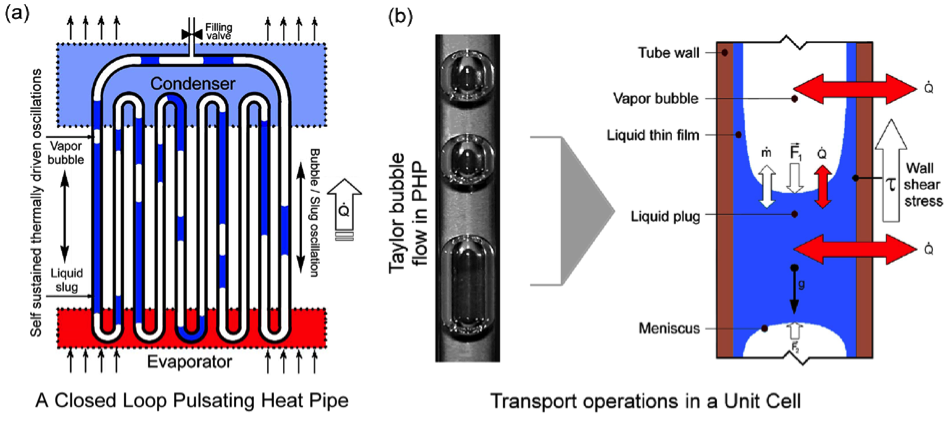 Pulsating Heat Pipes.
Pulsating Heat Pipes.

The liquid bridge: A paradigm for thermocapillary flow
Hendrik C. Kuhlmann
Prof. Hendrik C. Kuhlmann
Institute of Fluid Mechanics and Heat Transfer
Vienna University of Technology
Resselgasse 3, A-1040 Vienna, Austria
h.kuhlmann@tuwien.ac.at
Hendrik C. Kuhlmann was born in 1955 in Munster (Germany) where he studied Physics at WWU. In 1986 he received his PhD from U Saarbrucken with analytical and numerical work on Taylor-Couette flow being strongly influenced by his teacher M. Lucke. Based on his PhD H. Kuhlmann was awarded a Humboldt fellowship in 1987 to work with G. P. Neitzel at ASU Tempe who introduced him to thermocapillary convection. Returning to Germany H. J. Rath enabled H. Kuhlmann to continue his work on thermocapillary flow at ZARM (U Bremen) which led to his Habilitation in 1997. In 2003 H. Kuhlmann was appointed full professor of Numerical Fluid Mechanics at TU Wien. He was among the first to compute 3D flow instabilities in liquid bridges. He also introduced and analyzed the two-sided lid-driven cavity which exhibits a multitude of vortex instabilities. Recently, he discovered the mechanism of particle accumulation in periodic vortex flows by way of particle-boundary interaction. Quite generally, the work of H. Kuhlmann is driven by the search for physical mechanisms in fluid mechanics.

Dynamics of droplets moving on solid surface: Lattice Boltzmann simulations
Alexandr L. Kupershtokh
Prof. Alexandr L. Kupershtokh
Lavrentyev Institute of Hydrodynamics
Siberian Branch of Russian Academy of Sciences
Prosp. Lavrentyeva 15, 630090 Novosibirsk, Russia
and Department of Physics, Novosibirsk State University
Pirogova str. 2, 630090 Novosibirsk, Russia
skn@hydro.nsc.ru
http://ancient.hydro.nsc.ru/sk/
Alexandr Kupershtokh is currently Head of Laboratory of Multiphase Media and Cumulation at Lavrentyev Institute of Hydrodynamics of Siberian Branch of Russian Academy of Sciences (Novosibirsk, Russia). He obtained his Ph.D. and Doctor in Science degrees in Physics and Mathematics at this Institute in 1981 and 2007, respectively. He became Associate Professor in 1992 and Professor in 2010 at the Department of Physics of Novosibirsk State University. He published about 50 papers in international journals (Phys. Rev. E, J. Phys. D, Comp. & Math. Appl., J. Electrostatics, Tech. Phys. Lett. etc). One of his articles (A. L. Kupershtokh, D. A. Medvedev, D. I. Karpov, On equations of state in a lattice Boltzmann method, Computers and Mathematics with Applications, 2009, Vol. 58, N 5) is currently in the top 1% of highly sited papers in academic field of Mathematics in Web of Science database. His current research is concerned with simulations of wide range of physical phenomena (dielectric liquids in strong electric fields, thin liquid films, thermocapillary convection, droplets on solid substrates) using the lattice Boltzmann method.
Abstract
The behavior of thin liquid films and droplets placed on the surface of solid substrates are very important in modern technologies. The lattice Boltzmann method (LBM) was successfully implemented for computer simulation of these three-dimensional problems. The lattice Boltzmann method describes the viscous flows of fluids with an arbitrary equation of state and simulates the interfaces between vapor and liquid phases with a surface tension. The effect of solid walls on fluids is simulated by special forces acting between the nodes representing the solid boundaries and the nodes belonging to the liquid or vapor phases. The three-dimensional dynamics of droplets on inclined and vertical walls in gravity was simulated. Non-slip boundary conditions were used. The simulations of a rupture of the liquid films on the surface of a solid substrate due to the thermocapillary effect (Marangoni effect) were also carried out. For all computer simulations the Graphics Processing Units (GPUs) were exploited.
 Marangoni effect: (a) thin film on nonwettable solid substrate.
Marangoni effect: (a) thin film on nonwettable solid substrate.
(b) free-hanging thin film at prescribed non-axisymmetric temperature distribution.
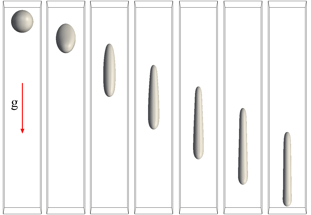 Droplet flowing down vertical wall in gravity.
Droplet flowing down vertical wall in gravity.
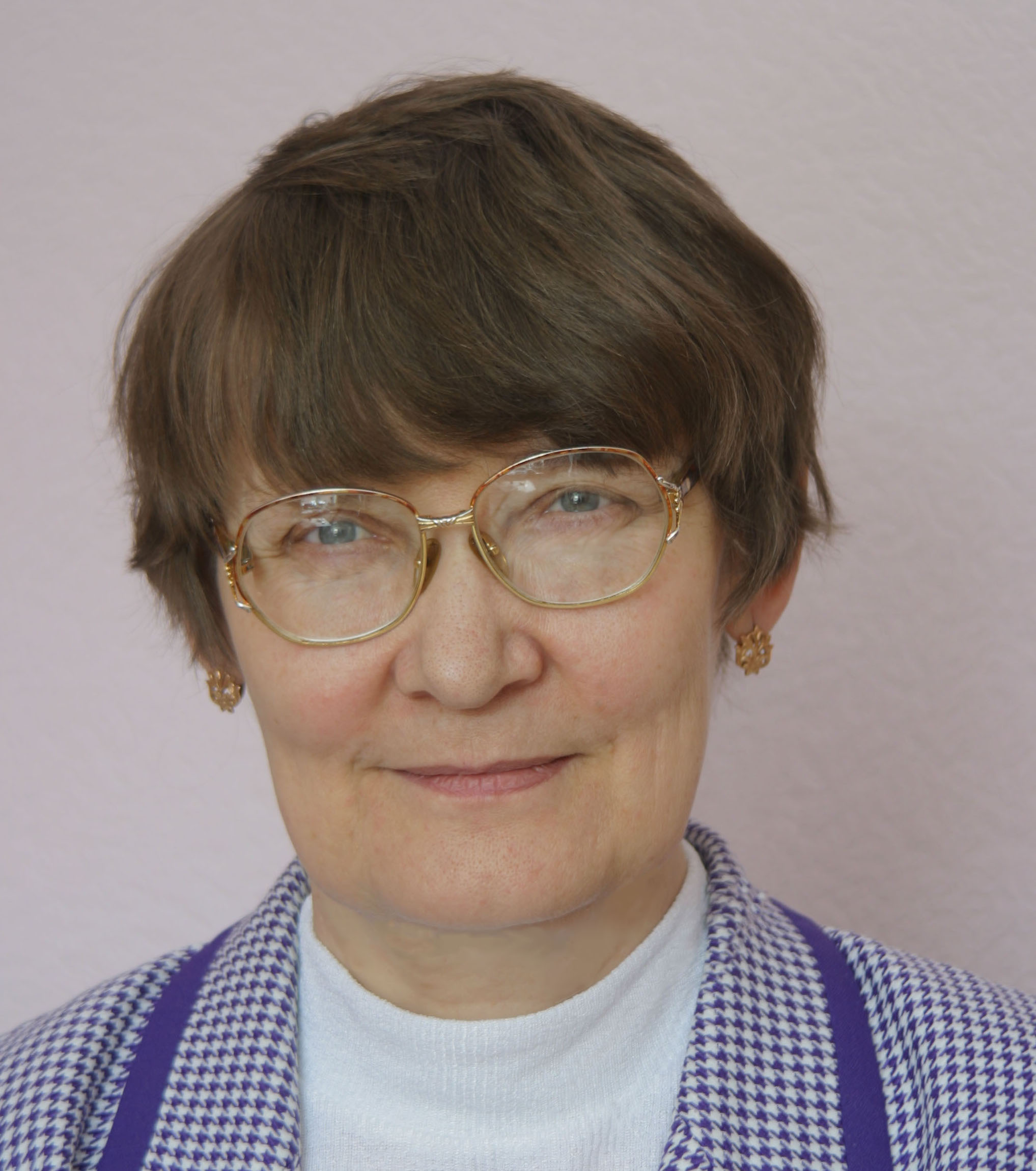
Rayleigh-Benard, Marangoni and Vibrational Instabilities in Two-Layer Systems with Deformable Interfaces
Tatyana Lyubimova
Prof. Tatyana Lyubimova
Institute of Continuous Media Mechanics UB RAS
Computational Fluid Dynamics Laboratory
1, Koroleva Str., 614013, Perm, Russia
lubimova@psu.ru
Professor Tatyana Lyubimova was graduated from Perm State University and obtained her PhD degree from Tomsk State University and Doctor of Science degree from Perm State University. She is Head of Computational Fluid Dynamics Laboratory at the Institute of Continuous Media Mechanics Ural Branch of Russian Academy of Sciences and Professor at the Theoretical Physics Department of Perm State University. Her main research directions are hydrodynamic stability, multiphase flows and vibrational fluid dynamics. She is a Leader of Perm Hydrodynamical School having the status of Leading Scientific School of Russian Federation. T. Lyubimova is co-author of the book "Dynamics of Fluid Interfaces in Vibrational Field" published in 2003 by PhysMathLit., Moscow. She is a member of Russian National Committee on Theoretical and Applied Mechanics and a member of Council on Space of Russian Academy of Sciences.

Nucleate boiling "Frontiers":boiling inception and boiling crisis
Paolo Di Marco
Prof. Paolo Di Marco
DESTEC, University of Pisa
Largo Lazzarino 1, 56122 Pisa, Italy
p.dimarco@ing.unipi.it
Paolo Di Marco is currently Associate Professor in Engineering Thermodynamics and Heat Transfer at the School of Engineering, University of Pisa, Italy. He graduated in Nuclear Engineering in 1984 and obtained a Ph.D. in Nuclear Engineering Safety in 1989. During his scientific career, from 1995, he dedicated mostly on experimental investigations. His fields of interest include: Single-Phase and Boiling Heat Transfer, Bubble Dynamics, Heat Transfer in Microgravity, Effect of Electric Fields on Heat Transfer. He performed a wide experimentation on boiling in microgravity, in particular in the presence of electric fields, with several campaigns in parabolic flight, droptowers, sounding rockets and one satellite flight. He is member of the ESA Topical Team in Boiling and Evaporation, and of the International Topical Team on Fluids in Space. At present he is contributing to definition of experiments to be flown inside the International Space Station. He is author or co-author of more than 100 refereed papers in the specialized fields above. He is at present president of EUROTHERM (European Committee for the Advancement of Thermal Sciences and Heat Transfer) and member of the Executive Committee of ICHMT (International Centre for Heat and Mass Transfer).
Abstract
This paper has the (ambitious) aim to review and discuss the fundamental theories and the more recent findings at the "frontiers" of nucleate boiling, i.e. its boundaries: nucleation onset and CHF, where its efficient performance is terminated. Nucleate boiling and is dominated by bubble dynamics, however in the past years it has become increasingly evident that multiple thermal and chemical interactions with the heated surface cannot be discounted.
In the recent past, the development of new and sophisticated diagnostic techniques has allowed a substantial gain of knowledge of the phenomena taking place at micro- and meso-scale on the boiling surface. At the same time, new technologies allowed for performing experimentation in exotic environments like the variable-gravity ones, or for developing of innovative surfaces of controlled morphology. The investigation on ultrasmooth, superhyprophobic and nano-structured surfaces on one hand opened new promising fields for industrial application, and on the other hand disclosed new features that forced to "re-think" and integrate the basic knowledge on boiling heat transfer, developed in the past 60 years. New theories and explanations have been set forth to account for new experimental findings, but at the same time the need arises to take into account and "re-discover" old and valuable contributions, often forgotten or hidden in aged and dusty xerox papers in our shelves.
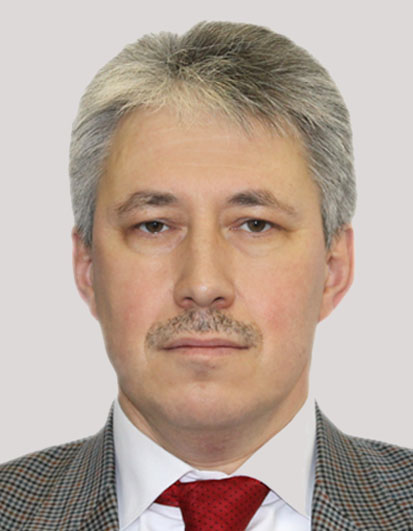
Wavy structure and liquid entrainment in annular flows
Dmtriy M. Markovich
Prof. Dmtriy M. Markovich
Deputy Director of the Kutateladze Institute of Thermophysics
Lavrentyev Ave., 1, 630090, Novosibirsk, Russia
dmark@itp.nsc.ru
Prof. Dmtriy M. Markovich is a Deputy Director of the Institute of Thermophysics. He is a corresponding member of Russian Academy of Sciences, member of Russian National Committee on Heat and Mass Transfer, Russian National Committee on Mechanics. His areas of expertise are the physics of wavy liquid films, hydrodynamics of multiphase flows, experimental flow diagnostics. He has over 200 scientific publications including about 80 peer review journal articles and more than 15 patents. Most recent results of Prof. Markovich and his group concern the application of modern optical techniques (Particle Image Velocimetry, Laser Induced Fluorescence) to the single- and multiphase flows diagnostics and also swirling gas-phase flames.
D. Markovich is a member of Editorial Boards of "Int. Journal of Heat and Fluid Flow", "Flow, Turbulence and Combustion", "Journal of Engineering Thermophysics", "Thermophysics and Aeromechanics" and others, member of Organizing and Scientific Committees of international symposiums: "Turbulence, Heat and Mass Transfer", "Two-Phase Systems for Ground and Space Applications", "Particle Image Velocimetry", "Application of Laser Techniques to Fluid Mechanics", "International Symposium of Flow Visualization", etc.
Abstract
The extended abstract is available here.

Non-isothermal interfacial flows: more interest and intrigue
Omar K. Matar
Prof. Omar K. Matar
Professor of Fluid Mechanics
Editor-in-Chief of Multiphase Science & Technology
Associate Executive Editor Journal of Engineering Mathematics
Editorial Board member of International Journal of Multiphase Flow
Department of Chemical Engineering, Room 517
Imperial College London,Prince Consort Road, London SW7 2AZ
o.matar@imperial.ac.uk
http://www3.imperial.ac.uk/people/o.matar
Prof. O. K. Matar (OKM) is a Fellow of the American Physical Society, an Exxon-Mobil Fellow, and a Professor of Fluid Mechanics in the Department of Chemical Engineering at Imperial College London. OKM has studied a wide range of problems in fluid mechanics including interfacial flows in the presence of Marangoni stresses (arising from surfactant, and/or temperature gradients), phase change, electric and magnetic fields, nanoparticles, and complex rheology. OKM has given over 50 invited presentations, and co-authored over 160 journal articles (h-index 31). He is the current Editor-in-Chief of Multiphase Sci. & Tech., co-Editor-in-Chief (elect) of J. Eng. Math., and on the Editorial Board of Int. J. Multiphase Flow. He is the Principal Investigator of a £5M programme (MEMPHIS) to produce the next-generation predictive tools for multiphase flows, and Deputy Director of a Centre for Doctoral Training in Fluid Dynamics across Scales at Imperial (www.icfluids.org).
Abstract
In this talk, we will present examples of novel phenomena associated with interfacial flows in the presence of thermocapillarity, buoyancy, and viscous, inertial, surfactant-induced, and phase change effects. We consider the three-dimensional (3D) dynamics of a gas bubble in a non-isothermal so-called "self-rewetting" fluid, whose surface tension exhibits a parabolic dependence on temperature. We show that the bubble ascent, retardation (and potential arrest), descent, and lateral migration, have no analogues in simple, "linear" fluids. We also show that the spreading of sessile drops of self-rewetting fluids on heated substrates exhibits can exhibit features associated with "super-spreading" phenomena, usually driven by surfactants or electric fields. Evaporating self-rewetting droplets on uniformly-heated walls also have spreading exponents that display an intriguing non-monotonic dependence on substrate temperature, and fingering instabilities near the contact line. We also show how surfactants could modify the evaporative flux in nano-particulate droplets of simple fluids, and influence their wall deposition patterns. Finally, we consider the 3D evaporation of non-axisymmetric drops of pure fluids and binary mixtures. We show that their life-time and bulk flow characteristics, including roll and hydrothermal wave-formation, depend on their size and shape, and the substrate non-uniform wettability.

Copper-Water Loop Heat Pipes - Highly Efficient Two-Phase Heat Transfer Devices
Yu. F. Maydanik
Prof. Yu. F. Maydanik
Heat-transfer devices laboratory
Institute of Thermal Physics of Ural Branch Russian Academy of Science
Russian Academy of Science
Ekaterinburg, Russia
maidanik@etel.ru
Yury Folievich Maydanik is currently a Head of Heat-transfer devices laboratory at the Institute of Thermal Physics of Ural Branch of Russian Academy of Science (Ekaterinburg, Russia). He obtained a Ph.D. in 1977 and became a Professor in 1994. In 1999 Prof. Maydanik was bestowed the title of Laureate of the State Prize, which is the highest award for the scientists in the field of science and technology in the Russian Federation. Prof. Maydanik is the author of more than 190 scientific articles and more than 60 inventions connected with the development and researches in the field of two phase heat-transfer devices with capillary pumping. He is a member of the National Committee on Heat and Mass Transfer. Since 2004 Prof. Maydanik is a chairman of the International Committee on Heat Pipes.
Abstract
Loop Heat Pipes (LHPs) are promising two-phase heat-transfer devices for providing an effective thermal link between a heat source and a heat sink in cooling systems of powerful electronics. Copper-water is the most effective "constructional material - working fluid" combination for LHPs, operating in the temperature range from 50 to 100 C°. Thermophysical properties of this combination make it possible to achieve an extremely high heat flux and low thermal resistance of copper-water LHPs. Today the obtained values of these parameters are close to 900 W/cm2, and 0,05 C°/W respectively. However, making such devices one has to overcome a serious contradiction between the high thermal conductivity of copper and low value dP/dT, which water has at the temperature below 100C°. The paper presents the results of the development, experimental and numerical investigation of copper-water LHPs with cylindrical and flat evaporators. The examples of use of the given devices in cooling systems in different areas of electronics are shown here.
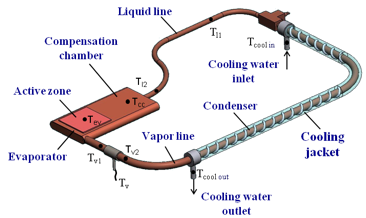 Copper-water LHP
Copper-water LHP
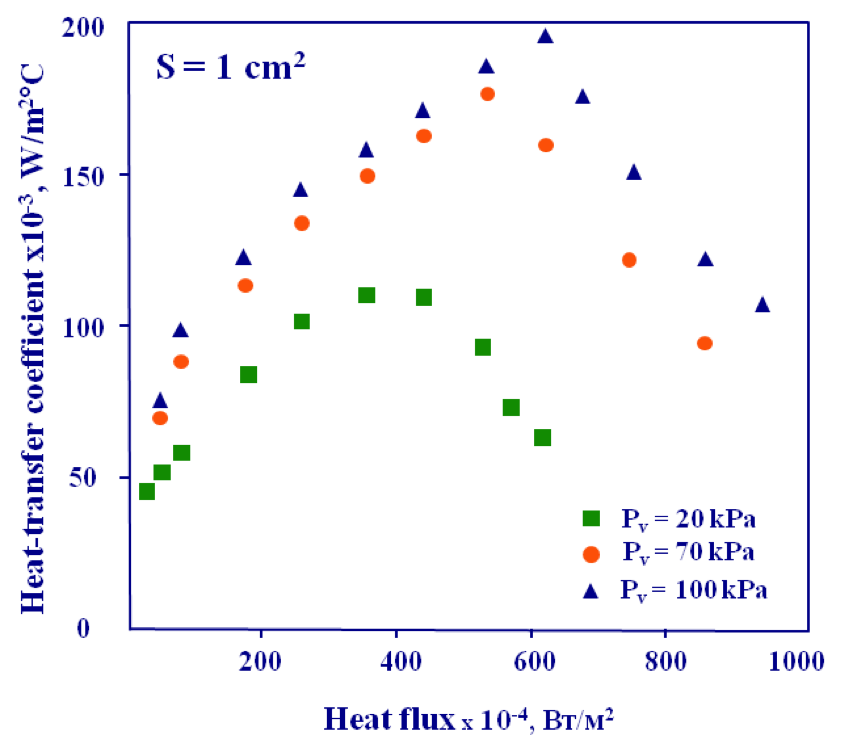 Heat-transfer coeff. in the evaporation zone vs Heat flux
Heat-transfer coeff. in the evaporation zone vs Heat flux
The extended abstract is available here.
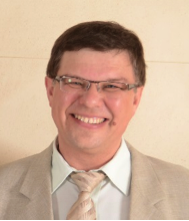
Slowed-down boiling crisis: experiments and modeling
Vadim Nikolayev
Dr. Vadim Nikolayev
Division of Fundamental Research (DRF)
Institute of Matter and Radiation (IRAMIS)
Laboratory of Condensed Matter Physics (SPEC)
Group of physical systems out of equilibrium, hydrodynamics, energy, and complexity (SPHYNX)
Service de Physique de l'Etat Condense
Office 227, bldg. 772, Orme des Merisiers
91191 Gif sur Yvette Cedex, France
vadim.nikolayevcea.fr
Dr. Vadim Nikolayev graduated from the Radio-Physics Department of Kiev State University (Ukraine, ex-USSR at the time) in 1985 and received his Ph.D. degree in Physics in 1989 from the same university. He was a staff researcher at the Institute for Theoretical Physics in Kiev in 1988-1999. He took visiting positions in France and USA (CEA/Saclay, 1995-1996, CEA/Grenoble 1997-1998 and Physics Department of the University of New Orleans, USA, 1998-1999). Since 1999 he works as a staff researcher at the French Alternative Energies and Atomic Energy Commission (CEA). He has defended his habilitation thesis in 2005. As a member of the Team of supercritical fluids for environment, materials and space (ESEME) created jointly by CEA, CNRS and ESPCI, he was based at several laboratories: Laboratory of low temperatures (SBT) at Grenoble (1999-2000), Institute of Condensed matter chemistry (ICMCB) at Bordeaux (2000-2004), Laboratory of physics and mechanics of heterogeneous media (PMMH/ESPCI) at Paris (2004-2013). Since 2013, he is based at the Laboratory of Condensed Matter Physics (SPEC) at the CEA Saclay center situating in the Paris suburb. His fields of interest include the physics and fluid mechanics associated with phase changes in fluids (evaporation, condensation, boiling, triple contact line dynamics), theory and experiments under reduced gravity conditions with pure fluids near their liquid-vapor critical point. Last years he directs a research program on the experiments and modeling of the pulsating heat pipes carried out at CEA. He is a member of the scientific committee of the French-German program COMPERE that deals with the behavior of cryogenic liquid fuel in the reservoirs of the space vehicles and the author of more than 50 papers in the refereed journals.
Abstract
Despite decades of research, the physical mechanisms that trigger the boiling crisis are still not understood mainly because its observation is very difficult under usual conditions where the boiling is violent and boiling crisis lasts less than 1ms. Our experiments have been carried out in a close vicinity of the liquid-gas critical point where the thermal diffusivity is very small so that boiling is slow: in our experiments it lasts up to 10 s. In addition the critical heat flux (CHF), a threshold at which BC occurs, becomes very small which is convenient for experiments. However, the surface tension decreases too. It is thus necessary to carry out the experiments under reduced gravity conditions to preserve conventional bubble geometry (to avoid the flattening of the gas-liquid interfaces by gravity). We report here two kinds of low gravity saturated boiling experiments. First, we discuss the experiments carried out at ISS in the DECLIC CNES apparatus with the SF6 fluid at 46°C. Second, the experiments conducted in a ground-based magnetic gravity compensation installation at Grenoble are addressed. This installation provides 1% precision of gravity compensation in the fluid volume of about 2 cm3. In both cases the observation of the bubble growth on a heater is performed both sidewise and "from below", through the transparent heater made with the ITO film. Although magnetic gravity compensation experiments provide much more versatility (a possibility of changing in situ the view angle, the fluid pressure, the gravity level etc.), experiments are possible only with one cryogenic fluid (H2 at 33K). They also impose a spatial variation of effective gravity that leads to a particular phase distribution in the fluid cell. The DECLIC experiments are complementary since they are incomparably more precise and show thus much more details of BC. In this communication, we discuss the BC dynamics and its mechanisms. We show experimentally that, in agreement with theoretical predictions, CHF of saturated boiling tends to zero in zero gravity, i.e. BC is observed at any heat flux provided the experiment lasts long enough. Due to the magnetic gravity compensation, we show the relationship between the classical boiling at low pressure and the DECLIC experiments. We review our theoretical and simulation work and show the common features of boiling at high heat fluxes and dryout of pulsating heat pipes.

Boling Heat Transfer to Immiscible Mixtures for High-performance Cooling of Semiconductors
Haruhiko Ohta
Prof. Haruhiko Ohta
Kyushu University, Faculty of Engineering
Department of Aeronautics and Astronautics
Motooka 744, Nishi-ku, Fukuoka 819-0395, Japan
ohta@aero.kyushu-u.ac.jp
Haruhiko Ohta is a professor of Dept. Aeronautics and Astronautics in Kyushu University, Japan. He is collaborating with JAXA as a principal investigator in the flow boiling experiment onboard ISS to be scheduled in 2016. To obtain the maximum scientific and technological output, the experimental results will be analyzed by the collaboration of researchers in the world as an activity of International Topical Team directed by ESA. Recently, he collaborates with Japanese and foreign industries to develop high-performance cooling systems for semiconductors with high-heat flux densities from large areas by the application of boiling heat transfer. He found superior heat transfer characteristics of immiscible mixtures in both systems of pool boiling and flow boiling.
Abstract
To satisfy the requirements for the cooling of small and large semiconductors operated at high heat flux density, an innovative cooling method using boiling heat transfer to immiscible liquid mixtures is proposed.
Because of the self-sustained high subcooling of less-volatile liquid by the high vapor pressure of more-volatile component, the value of CHF in pool boiling is increased up to 300W/cm2 for FC72/water by using a flat heating surface of 40mm in diameter facing upwards under the pressure 0.1MPa. Furthermore, the temperature of heating surface is reduced at high heat flux by the enhanced heat transfer to less-volatile liquid assisted by the bubble generation from the more-volatile component.
To apply such the superior heat transfer characteristics in boiling of immiscible mixtures to flow boiling system, fundamental experiments using a horizontal heated tube are performed and the classification of flow patterns including liquid-liquid interface, and corresponding heat transfer performance are discussed.
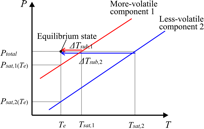 Equilibrium state of immiscible mixture
Equilibrium state of immiscible mixture
 Flow patterns of FC72/Water under unheated conditions
Flow patterns of FC72/Water under unheated conditions
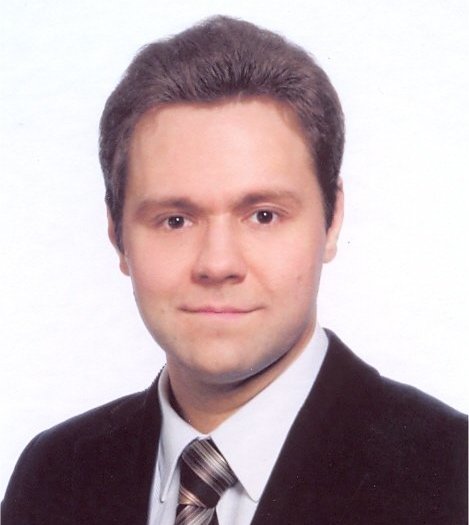
Thermocapillary flows and their stability in pure fluids and binary mixtures
Ilya I. Ryzhkov
Ilya I. Ryzhkov
Leading researcher
Department of Differential Equations of Mechanics
Institute of Computational Modelling SB RAS
Akademgorodok 50 - 44, 660036 Krasnoyarsk, Russia
rii@icm.krasn.ru
Ilya I. Ryzhkov was born in 1980 in Krasnoyarsk, Russia and graduated from Krasnoyarsk State Technical University in 2002 (Applied mathematics & Translator of the English language). He received his PhD degree from Novosibirsk State University, Russia in 2005 and Doctor of Sciences degree from the Institute of Continuous Media Mechanics (Perm, Russia) in 2014. During 2006 - 2009, he held a postdoctoral position at the Free University of Brussels, Belgium. Presently, Ilya I. Ryzhkov is a leading researcher at the Institute of Computational Modelling SB RAS and a Professor of Siberian Federal University. He has published more than 30 papers in peer-reviewed internationally recognized journals and the monograph "Thermal diffusion in mixtures: equations, symmetries, solutions, and their stability".
The scientific interests of Dr. Ryzhkov are related to theoretical fluid mechanics and applications of mathematical methods to physics. The research is focused on heat and mass transfer processes in fluids: convection, heat and mass diffusion, and the Soret effect (or thermal diffusion). In particular, the scientific studies include convective stability of mixtures with many components, vibrational phenomena in fluids, and development of theoretical foundations for experimental methods of transport coefficients measurement. With respect to mathematical methods, the research is focused on symmetry analysis of differential equations (applications of Lie groups to ordinary and partial differential equations). It includes the study of symmetry properties for different models of fluid mechanics as well as construction and classification of their exact solutions.
Abstract
The dynamics of fluid systems with interfaces remains a challenging problem of modern physics. In such systems, the variation of surface tension due to thermal or compositional gradient along the interface can cause convective flows in the bulk fluid. This effect is especially important in weightlessness, where buoyancy convection is absent and thermocapillary forces often constitute the sole cause of motion. Thermocapillary flows play an important role in many natural and technological processes, such as propagation of liquid jets, motion of thin liquid films, evolution of ocean waves, etc.
Thermocapillary effect essentially affects the process of crystal growth by floating-zone method. To study the motion of melt in the full floating zone between the feed material and crystal, the so-called half-zone or liquid bridge model is often used. In this model, the fluid is placed between two rods (hot and cold), and the thermocapillary flow appears due surface tension gradient on the free surface. Liquid bridge has become a paradigm of a complex dynamical system and is often used for investigating the thermocapillary effect. Linear stability analysis of stationary thermocapillary flow in an infinite liquid bridge was first performed by Xu and Davis in 1984. We revisited this analysis and found a new instability mode in the range of high Prandtl numbers (Ryzhkov 2011). The existence of new mode was confirmed by recent microgravity experiments performed by Japanese researchers in the KIBO module of the International Space Station (Yano et al, 2015).
References
- Xu J.J. and Davis S.H. Convective thermocapillary instabilities in liquid bridges. Phys. Fluids, V. 27, 1102 (1984)
- Ryzhkov I.I. Thermocapillary instabilities in liquid bridges revisited. Phys. Fluids, V. 23, 082103 (2011)
- Yano T., Nishino K., Kawamura H., Ueno I., and Matsumoto S., Instability and associated roll structure of Marangoni convection in high Prandtl number liquid bridge with large aspect ratio. Phys. Fluids, V. 27, 024108 (2015)
The extended abstract is available here.

Superhydrophobic Microfluidics
Olga I. Vinogradova
Prof. Dr. Olga I. Vinogradova, MAE
A.N.Frumkin Institute of Physical Chemistry and Electrochemistry
Russian Academy of Sciences
Leninsky Prospect 31, 119071 Moscow, Russia
and Department of Physics, M.V.Lomonosov Moscow State University
119991 Moscow, Russia
oivinograd@yahoo.com
Olga I. Vinogradova obtained her Diploma and Ph.D. degrees from the National University of Science and Technology MISIS. She then joined the Laboratory of Physical Chemistry of Modified Surfaces, part of the A.N.Frumkin Institute of Physical Chemistry and Electrochemistry (Russian Academy of Sciences), as a research fellow. Since 1993 she directs this Laboratory. In 2000 she got her D.Sci. (Habilitation) degree in Physics and Mathematics from the A.N.Frumkin Institute. The same year she was offered an Associate Professor position at the Max Planck Institute for Polymer Research, where she headed the independent research group "Colloid and Interface Science". Since 2009 she joined the Physics Department of the M.V.Lomonosov Moscow State University as a full professor, where she has organized the new Laboratory of Micro- and Nanofluidics. Olga published ~ 100 papers in international journals (involving Phys. Rev. Lett., Phys. Rev. E, J. Chem. Phys., J. Fluid Mech., Lab Chip, etc) which have been cited ~3500 times for a h-index ~40. In 2012 she has been elected to Academia Europaea. Olga's current research is concerned with the application of physical and mathematical methods to problems arising at the interface between soft condensed matter, fluid and solid mechanics, and nanoscience. She combines theory, simulations and experiments, the goal being to iterate between the three until consistent physical pictures and theoretical models emerge.
Abstract
Superhydrophobic surfaces have opened a completely new field of investigation with both fundamental and practical perspectives. Research on these materials has mostly focused on their extreme non-wettability, which has large-scale implications in the context of self-cleaning and impact processes. However, the implications of superhydrophobicity for transport phenomena, which are especially important at micro- and nanoscales, remain largely unexplored. In my talk, I will discuss a current switch in focus from wetting to related areas such as the remarkable drag-reducing ability of superhydrophobic materials. In particular, I will show that superhydrophobic surfaces induce novel hydrodynamic properties such as giant effective slip, superfluidity, transverse hydrodynamic phenomena, and dramatically affect electrokinetic phenomena. I will also discuss strategies in the fabrications of superhydrophobic materials for relevant applications, including new types mixing and separation in microfluidic lab-on-a-chip devices.
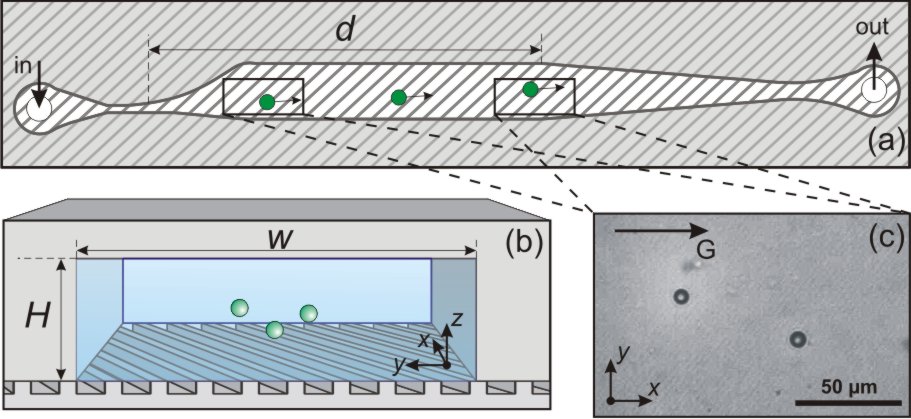 Separation of the particles in superhydrophobic channel
Separation of the particles in superhydrophobic channel
